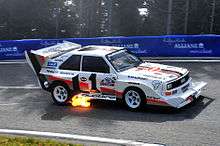Pikes Peak International Hill Climb
The Pikes Peak International Hill Climb (PPIHC), also known as The Race to the Clouds, is an annual automobile and motorcycle hillclimb to the summit of Pikes Peak in Colorado, USA. The track measures 12.42 miles (19.99 km) and has over 156 turns, climbing 4,720 ft (1,440 m) from the start at Mile 7 on Pikes Peak Highway, to the finish at 14,115 ft (4,302 m), on grades averaging 7.2%.[1][2] It used to consist of both gravel and paved sections, however as of August 2011, the highway is fully paved and as a result all subsequent events will be run on asphalt from start to finish.[3]
 | |
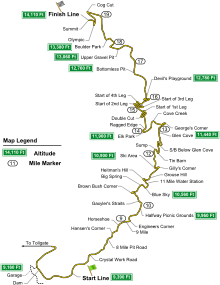 | |
| Location | Colorado Springs, Colorado USA 38.84°N 105.04°W |
|---|---|
| First race | 1916 |
| Distance | 12.42 mi (20 km) |
| Circuit information | |
| Surface | Tarmac (historically, dirt) |
| Turns | 156 |
| Lap record | 7:57.148 (Romain Dumas, Volkswagen I.D. R Pikes Peak, 2018, Unlimited) |

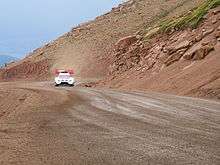
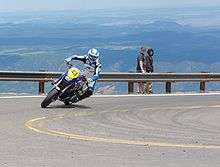
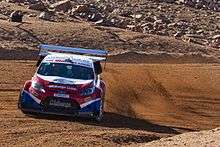
.jpg)
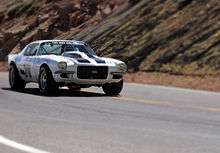
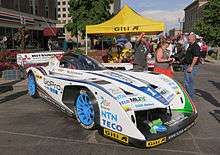
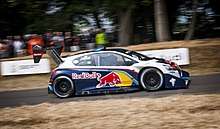
The race is self-sanctioned and has taken place since 1916.[1][2] It is currently contested by a variety of classes of cars, trucks, motorcycles and quads. There are often numerous new classes tried and discarded year-to-year. On average there are 130 competitors. The PPIHC operates as the Pikes Peak Auto Hill Climb Educational Museum to organize the annual motorsports event.[1]
History
Early history
The first Pikes Peak Hill Climb was promoted by Spencer Penrose, who had converted the narrow carriage road into the much wider Pikes Peak Highway.[4]
The first Penrose Trophy was awarded in 1916 to Rea Lentz with a time of 20:55.60.[4][5][6] In the same year Floyd Clymer won the motorcycle class with a time of 21:58.41.[7] In 1924 the final Penrose Trophy was awarded to Otto Loesche in his Lexington Special.[8] In the years following, Glen Scultz and Louis Unser shared a rivalry and won the event 12 times between them.[5] In 1929 the popular stock car class was added to the event.[4][6]
Following world war two, Louis Unser returned to his winning ways at Pikes Peak, winning a further three more times between 1946 and 1970, these wins were tightly contended with rival Al Rogers.[4][5] During this time the event was part of the AAA and USAC IndyCar championship.[9] In 1953, the Sports Car Club of America (SCCA) sponsors the event, bringing with it an influx of sports cars. In this period the course record was broken every year from 1953 until 1962, this is the largest string of record breaking runs in the event's history. The majority of these records were set by Louis nephew, Bobby Unser.[5] In 1954 motorcycles return to the event, the first time since its inception 1916.[6] The motorcycle overall victory that year went to Bill Meier riding a Harley-Davidson motorcycle.[7]
In 1971 the event was won by the first non-gasoline vehicle (propane), this was also the first overall victory from the stock car class (1970 Ford Mustang), the car was driven by the Danish-American Ak Miller.[6]
European involvement
In 1984 the first European racers took part in the PPIHC with Norwegian Rallycrosser Martin Schanche (Ford Escort Mk3 4x4) and French Rally driver Michèle Mouton (Audi Sport quattro), thereby starting a new era for European teams in the almost unknown American hillclimb.[10] While Schanche failed to set a new track record, due to a flat right front tire, Mouton (together with her World Rally Championship co-driver Fabrizia Pons from Italy) won the Open Rally category, but failed to win the event overall. Mouton achieved the overall victory and course record in the following year.[10][7]
In 1989, an award-winning short film about the 1988 event was released by French director Jean-Louis Mourey. The film, titled Climb Dance, captured the efforts of Finnish former World Rally Champion Ari Vatanen, as he won the event in a record-breaking time with his turbocharged Peugeot 405 Turbo 16.[5][7][11]
Paving of the highway
The City of Colorado Springs began to pave the highway in 2002 after losing a lawsuit against the Sierra Club, which sued on account of erosion damage to streams, reservoirs, vegetation and wetlands downstream from the 1.5 million tons of road gravel deposited over several decades.[12][13] The local authority paved approximately 10% of the route each year after the order. The 2011 event was the last race with dirt sections, comprising approximately 25% of the course.[3]
During this evolutionary period of the event, the Japanese driver Nobuhiro Tajima with Suzuki cars scored 6 overall victories (2006 - 2011) and two course records.[4][10] His 2011 record was the first to break the 10 minute barrier.[5]
Hill Climb champion Rod Millen warned at the time that paving the road would put an end to the race.[14] However, the 2012 race saw over 170 racer registrations by December 2011, compared with 46 at the same time the previous year.[15]
The 90th running of the event happened in 2012 and saw a larger field and a longer race day than ever before. This was the first time the race has been run on all asphalt leading to the breaking of several records, notably the overall record, which fell numerous times during the event finally falling to Rhys Millen the son of previous event winner Rod Millen, in the Time Attack Division. During the event Mike Ryan spun his big rig in a hairpin in a section called the "W"s, hitting the guard rail, he then managed to execute a three-point turn and continued on course, at which point he broke his old record by 5 seconds. This highlighted the change that a fully paved course made to the speed of the event.[16] The 2012 event also saw the first motorcycle to achieve a sub 10 minute time with the late Carlin Dunne in the 1205 Division riding a Ducati with a time of 9:52.819 which was only 1.5 seconds slower than the previous year's overall record.
2013 saw the nine-minute barrier shattered by WRC legend Sébastien Loeb (Peugeot 208 T16 Pikes Peak), with a time of 8:13.878, while Rhys Millen ended up second with 9:02.192, beating his own record by more than 44 seconds.[17] Jean-Philippe Dayrault finished third with a time of 9:42.740, and Paul Dallenbach fourth with a time of 9:46.001, making it four drivers to beat the overall record set only the previous year.
Emergence of electric vehicles
Electric cars have featured on and off in the PPIHC since the early 1980s. In 1981 Joe Ball took a Sears Electric Car to the top in 32:07.410, in 1994 Katy Endicott brought her Honda to the top in 15:44.710 and in 2013 Nobuhiro Tajima broke the 10 minute barrier with a time of 9:46.530 in his E-RUNNER Pikes Peak Special. In the following years electric entries would become more common, steadily breaking their powertrain records and eventually the overall record in 2018.[5][7][18]
For hill-climb events and this event in particular it is reasonable to suggest that a modern, well designed electric car will be at an advantage over internal combustion engined cars. The issue of limited range does not apply to short sprints and the twisty nature of the Pikes Peak course lends itself well to the almost instant torque delivery of electric motors. In addition to this, the lowering air density of high altitudes does not reduce the power available to the driver as it does with air breathing engines.[19][20]
Although the 2014 event was won by a gasoline powered car; second (Greg Tracy), third (Hiroshi Masuoka) and fourth (Nobuhiro Tajima) places overall were taken by electric cars.[21] In 2015, electric cars placed first (Rhys Millen) and second (Nobuhiro Tajima) overall.[22][23] In an interview with Rhys Millen, he said that he had lost power to the car's rear motor pack before the halfway point. Had this not happened he had expected his run to be 30 seconds faster.[24] In 2016 gasoline again took top honours but electric completed the podium taking second (Rhys Millen) and third (Tetsuya Yamano) as well as fifth (Nobuhiro Tajima) places overall.[25]
At the 2018 event, an electric car set a new overall record for the first time in the event's history. Frenchman Romain Dumas completed the course in the all-electric Volkswagen I.D. R with a time of 7:57.148, breaking the 8 minute barrier for the first time.[19][26]
Racing divisions
The Pikes Peak International Hill climb consists of ten divisions, six for cars and four for motorcycles. [27] Four additional special record classes consisting of former classes are defined in the appendix.[1]
Car divisions
- Unlimited
Anything goes in the Unlimited Division as long as it passes safety inspection and meets the PPIHC’s general rules. The Unlimited Division features the most exotic vehicles, most of them built specifically for this race. These race cars have the best chance of setting a new overall race record. In 2018, Romain Dumas set a new record of 7 minutes 57.148 seconds in the all-electric Volkswagen I.D. R Pikes Peak, beating Sébastien Loeb's previous record by over 15 seconds.[28]
- Time Attack 1
A division for production based two- and four-wheel drive vehicles. Only closed cockpit four-wheeled vehicles are allowed to participate.
- Porsche Pikes Peak Trophy by Yokohama
Making its debut at the 2018 event was the first official one-make Porsche category, exclusive to the Porsche Cayman GT4 Clubsport in four variants — Clubsport, Clubsport Trophy Specification, Clubsport MR, and Clubsport 2017 IMSA GS.
- Open Wheel
The traditional Pikes Peak single-seater race cars with designs ranging from Indy style sprinters to dune buggies. Open-wheel cars have competed in every event since the inaugural race in 1916.
- Pikes Peak Open
Production based vehicles with unlimited permitted modifications.
- Exhibition Class
In keeping with the mission statement of the event, specifically to "demonstrate advancements in the practical application of motor sports technology", the race encourages competitors with vehicles that do not meet the technical specifications of PPIHC sanctioned divisions to enter in the Exhibition Class. While there are no class records for this class because of its exhibition status, entries are eligible for recording an overall course record as well as an attempt at records achieved by former classes.
Motorcycle divisions and classes
- Pikes Peak Heavyweight
This is the top motorcycle division offered at Pikes Peak. It was formerly known as the Pikes Peak Open Motorcycle class. Competitors are eligible to enter vehicles powered by two or four-stroke engines of no more than four cylinders, displacing 851cc to 1305cc.
- Pikes Peak Middleweight
Competitors are eligible to enter vehicles powered by two or four-stroke engines of no more than four cylinders which displace between 501c to 850cc.
- Pikes Peak Lightweight
Competitors are eligible to enter vehicles powered by two or four-stroke engines of no more than two cylinders, displacing no more than 500cc.
- Exhibition Powersport Class
This division includes Utility Terrain Vehicles and other vehicles that don’t fit in other Pikes Peak Divisions. While there are no records for this class because of its exhibition status, entries are eligible for recording an overall course record as well as an attempt at records achieved by former classes.
Records from the Appendix of the Regulations
- Time Attack 2 Production Record
This class features production based two- or four-wheeled vehicles with minimal modification allowed. All cars entered must have a valid manufacturer issued VIN and a minimum production run of 500.
- Vintage Car Record
A class open to cars manufactured in 1995 or earlier, eligible vehicles must have competed in a past event.
- Sidecar Record
Motorcycle and sidecar, consisting of three wheels. The vehicle is quite unrestricted, but forced induction is not permitted and the vehicle must be able to safely and comfortably carry a passenger. If a sidecar entry is also entered in the Exhibition Powersport class, then a passenger is only permitted to ride during official practise sessions.
- Electric Motorcycle Record
Constructors of electric vehicles are encouraged to showcase their engineering achievements and vehicles. Entry of vehicles with technology capable of speeds and performance compatible with past programs of the event is desired. All vehicles running under these rules must emit an audible warning at all times while they are on the course.
- Quad Record
Eligible to quads fitted with naturally aspirated engines which have homologation numbers exceeding 250. 2 stroke engines must have 1 or 2 cylinders and displace 250-550 cc. 4 stroke engines must be single cylinder, 450-750 cc models.
Race records
Below follows all currently recognised records. Records set during the most recent running of the event are in bold type.
Division and class records
| Current 4-Wheel Records[29] | |||||
|---|---|---|---|---|---|
| Division | Class | Year | Name | Vehicle | Time |
| Unlimited | 2018 | Romain Dumas | Volkswagen I.D. R[note 1] | 7:57.148 | |
| Time Attack | Time Attack 1 | 2019 | Raphaël Astier | b.b.i Autosport Porsche Turbo Cup | 9:23.721 |
| Pikes Peak Challenge Car | Open Wheel | 2017 | Clint Vahsholtz | 2013 Ford Open | 9:35.747 |
| Pikes Peak Open | 2019 | Peter Cunningham | 2019 Acura TLX GT | 9:24.433 | |
| Porsche Cayman GT4 Clubsport | 2018 | Travis Pastrana | 2016 Porsche Cayman GT4 Clubsport | 10:33.897 | |
| Current 2-Wheel Records[29] | |||||
|---|---|---|---|---|---|
| Division | Class | Year | Name | Vehicle | Time |
| Pikes Peak Heavyweight | 2019 | Rennie Scaysbrook | 2018 Aprilia Tuono V4 1100 | 9:44.963 | |
| Pikes Peak Middleweight | 2018 | Chris Fillmore | 2018 KTM 790 Duke | 10:04.038 | |
| Pikes Peak Lightweight | 2019 | Chris Fillmore | 2019 450 SX-F Factory Edition | 10:20.819 | |
| Pikes Peak Heavyweight | 2014 | Guy Martin | 2014 1300cc EXHIBIT | 11:32.558 | |
| Pikes Peak Challenge Motorcycle | Electric | 2013 | Carlin Dunne | 2013 Lightning Electric Superbike [note 1] | 10:00.694 |
| Quad | 2016 | Cyril Combes [note 2] | 2011 Suzuki KTM JF Prototype | 11:05.664 | |
Non-division and class records
| Records from the Appendix of the PPIHC Rule Book[1][29] | ||||
|---|---|---|---|---|
| Type | Year | Name | Vehicle | Time |
| Production SUV | 2018 | Rhys Millen | 2018 Bentley Bentayga | 10:49.902 |
| Time Attack 2 (Production) | 2019 | Rhys Millen | 2019 Bentley Continental GT | 10:18.488 |
| Vintage Car | 2017 | Spencer Steele | 1995 PVA 2 | 10:25.989 |
| Sidecar | 2016 | John Wood & Matthew Blank | 1999 Shelbourne Superlite F2 | 11:26.644 |
| Vintage Motorcycle | 2012 | Marc LaNoue | 1969 Triumph Bonneville | 12:39.782 |
| Alternative Fuel Records[29] | |||||
|---|---|---|---|---|---|
| Fuel | Division/Class | Year | Name | Vehicle | Time |
| Electric | Modified | 2018 | Romain Dumas | Volkswagen I.D. R | 7:57.148 |
| Production | 2016 | Blake Fuller | 2016 Tesla Model S P90D | 11:48.264 | |
| Diesel | Exhibition | 2015 | Uwe Nittel | 2016 Mercedes Benz C300 d 4 MATIC | 11:37.149 |
| Natural Gas | Open Wheel | 1993 | Johnnie Rogers | Wells-Coyote | 11:50.090 |
| Propane | Exhibition/PPO | 2012 | Randy Schranz | 2012 Shelby Cobra | 11:11.218 |
| Turbine | Open Rally | 1981 | Steve Bolan | Bolan-Allison | 15:27.180 |
| Hybrid | Time Attack 1 | 2018 | James Robinson | 2017 Acura NSX | 10:02.448 |
| Drivetrain Records[29] | |||||
|---|---|---|---|---|---|
| Drivetrain | Division/Class | Year | Name | Vehicle | Time |
| Front-Wheel Drive | Pikes Peak Open | 2018 | Nick Robinson | 2018 Acura TLX A-Spec | 10:48.094 |
| Rear-Wheel Drive | Unlimited | 2018 | Simone Faggioli[note 2] | 2018 Norma M20 SF PKP | 8:37.230 |
| All-Wheel Drive | Unlimited | 2018 | Romain Dumas | Volkswagen I.D. R[note 1] | 7:57.148 |
Winners
The Pikes Peak International Hill Climb is an event run by both cars and motorcycles. The overall honours have always fallen to vehicles in car divisions, however motorcycles have their own divisions, records and winners. Cars have entered the event every year since its inception in 1916 (with the exception of years during the world wars) whereas motorcycles have only entered in a limited number of years.
Overall winners
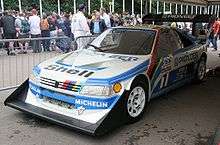

Overall winners can compete under any class of cars or motorcycles, although the majority come from the open wheel and more recently the unlimited classes. A time in italics indicates this was a previous course record, a time in bold indicates the current course record.
| Year | Winner | Vehicle | Time | Notes |
|---|---|---|---|---|
| 1916 | Romano Special | 20:55.600 | ||
| 1917-1919 | No competition due to World War I | |||
| 1920 | Lexington Special | 22:25.400 | ||
| 1921 | Hudson Special | 19:16.200 | ||
| 1922 | Ford Special | 19:50.900 | ||
| 1923 | Hudson Essex | 18:47.000 | ||
| 1924 | Lexington Special | 18:15.000 | ||
| 1925 | Chandler Special | 17:48.400 | ||
| 1926 | Stutz | 18:19.400 | ||
| 1927 | Stutz | 18:25.100 | ||
| 1928 | Stutz Special | 17:41.600 | ||
| 1929 | Shultz Stutz 8 | 18:22.800 | ||
| 1930 | Stutz DV-32 | 18:08.700 | ||
| 1931 | Hunt Special | 17:10.300 | ||
| 1932 | Shultz/Stutz Special | 16:47.200 | ||
| 1933 | Stutz DV-32 | 17:27.500 | ||
| 1934 | Stutz Special | 16:01.800 | ||
| 1935 | 1935 Chevrolet 1 1/2-ton Truck | 26:12.000 | [note 3] | |
| 1936 | Shultz Stutz | 16:28.100 | ||
| 1937 | Stutz DV-32 | 16:27.300 | ||
| 1938 | Loop Cafe Special | 15:49.900 | ||
| 1939 | Snowberger Special | 15:39.400 | ||
| 1940 | Joe Coniff Special | 15:59.900 | ||
| 1941 | Burd Special | 15:35.200 | ||
| 1942-1945 | No competition due to World War 2 | |||
| 1946 | Maserati | 15:28.700 | [note 4] | |
| 1947 | Maserati | 16:34.770 | [note 5] | |
| 1948 | Coniff Special Offenhauser | 15:51.300 | [note 5] | |
| 1949 | Coniff Special | 15:54.260 | [note 5] | |
| 1950 | Coniff Special | 15:39.000 | [note 5] | |
| 1951 | Offenhauser | 15:39.700 | [note 5] | |
| 1952 | Kurtis Kraft Offenhauser Special | 15:30.650 | [note 5] | |
| 1953 | Federal Engineering Special | 15:15.400 | [note 5] | |
| 1954 | Joe Hunt | 14:39.700 | [note 5] | |
| 1955 | Dick Frenzel Special | 14:27.200 | [note 5] | |
| 1956 | Unser Special | 14:27.000 | [note 6] | |
| 1957 | Dick Frenzel Special | 14:11.700 | [note 6] | |
| 1958 | Unser Special | 13:47.900 | [note 6] | |
| 1959 | Unser Special | 13:36.500 | [note 6] | |
| 1960 | Unser Special | 13:28.500 | [note 6] | |
| 1961 | Unser Special | 12:56.700 | [note 6] | |
| 1962 | Unser Special | 12:05.800 | [note 6] | |
| 1963 | Chevrolet 327 | 12:30.600 | [note 6] | |
| 1964 | Offenhauser | 12:24.500 | [note 6] | |
| 1965 | Harrison Ford | 12:54.300 | [note 7] | |
| 1966 | Chevrolet | 12:23.800 | [note 7] | |
| 1967 | Chevrolet | 12:46.300 | [note 7] | |
| 1968 | Rislone Special | 11:54.900 | [note 7] | |
| 1969 | Chevrolet STP Special | 12:44.070 | [note 7] | |
| 1970 | Chevrolet 303 | 12:41.100 | [note 6] | |
| 1971 | 1970 Mustang | 14:18.600 | ||
| 1972 | Volkswagen 2180 | 13:26.840 | ||
| 1973 | Volkswagen 2180 | 12:54.790 | ||
| 1974 | Sprint Chevrolet 302 | 12:54.770 | ||
| 1975 | Chevrolet 327 | 12:36.650 | ||
| 1976 | Porsche 2386 | 12:11.890 | ||
| 1977 | Chevrolet 350 | 12:15.720 | ||
| 1978 | Chevrolet | 11:55.830 | ||
| 1979 | Hoffpauir Wells Coyote Chevrolet | 11:54.180 | ||
| 1980 | 1970 Chevrolet 350 | 12:15.810 | ||
| 1981 | 1976 N-D Porsche | 12:03.960 | ||
| 1982 | Woziwodzki Wells Coyote Chevrolet | 11:44.820 | ||
| 1983 | Woziwodzki Wells Coyote Chevy | 11:38.300 | ||
| 1984 | 1981 Wells Coyote | 11:44.490 | ||
| 1985 | Audi Sport Quattro S1 | 11:25.390 | ||
| 1986 | Audi Sport Quattro SL | 11:09.220 | ||
| 1987 | Audi Sport Quattro E2 Pikes Peak | 10:47.850 | ||
| 1988 | Peugeot 405 Turbo 16 | 10:47.220 | ||
| 1989 | Peugeot 405 Turbo 16 | 10:48.340 | ||
| 1990 | Unser Chevrolet | 11:32.860 | ||
| 1991 | Donner-Dykstra Chevrolet | 11:12.420 | ||
| 1992 | Unser Chevrolet | 10:53.870 | ||
| 1993 | Davis Chevrolet | 10:43.630 | ||
| 1994 | Toyota Celica AWD Turbo | 10:04.060 | ||
| 1995 | Suzuki Escudo | 7:53.000 | [note 8] | |
| 1996 | Toyota Celica | 10:13.640 | ||
| 1997 | Toyota Celica | 10:04.540 | ||
| 1998 | Toyota Tacoma | 10:07.700 | ||
| 1999 | Toyota Tacoma | 10:11.150 | ||
| 2000 | 2000 GMC Envoy | 11:17.660 | ||
| 2001 | 1981 Wells Coyote | 10:39.760 | ||
| 2002 | 1997 Donner Dykstra | 10:52.300 | [note 9] | |
| 2003 | 2000 PVA-01 | 11:34.700 | [note 10] | |
| 2004 | Subaru Impreza STIE | 11:47.280 | [note 11] | |
| 2005 | Donner/Dykstra Special | 11:15.680 | [note 12] | |
| 2006 | Suzuki Escudo | 7:38.900 | [note 8][note 13] | |
| 2007 | Suzuki XL7 | 10:01.408 | [note 14] | |
| 2008 | Suzuki XL7 | 10:18.250 | [note 15] | |
| 2009 | Suzuki SX4 | 10:15.368 | [note 16] | |
| 2010 | Suzuki SX4 | 10:11.490 | [note 17] | |
| 2011 | Suzuki SX4 | 9:51.278 | [note 18] | |
| 2012 | Hyundai Genesis Coupe | 9:46.164 | [note 19] | |
| 2013 | Peugeot 208 T16 Pikes Peak | 8:13.878 | ||
| 2014 | Norma M20 RD-Honda | 9:05.801 | ||
| 2015 | eO PP03 | 9:07.222 | [note 1] | |
| 2016 | Norma M20 RD-Honda | 8:51.445 | ||
| 2017 | Norma M20 RD-Honda | 9:05.672 | ||
| 2018 | Volkswagen I.D. R | 7:57.148 | [note 1] | |
| 2019 | 2018 Wolf TSC-Honda | 9:12.476 | ||
Motorcycle winners
Motorcycle winners can compete under any class, although the majority come from open or large displacement classes. A time in italics indicates this was a previous motorcycle record, a time in bold indicates the current motorcycle record.
On 30 June 2019, four-time Pikes Peak International Hill Climb winner Carlin Dunne was killed in a crash at the race.[30] He crashed less than a quarter of a mile from the finish line.[30]
| Year | Winner | Vehicle | Time | Notes |
|---|---|---|---|---|
| 1916 | Excelsior | 21:58.410 | ||
| 1917-1953 | No motorcycle competition records | |||
| 1954 | Harley-Davidson | 15:34.100 | ||
| 1955 | Harley-Davidson | 16:08.600 | ||
| 1956-1970 | No motorcycle competition records | |||
| 1971 | Husqvarna | 15:11.960 | ||
| 1972 | Bultaco | 15:13.470 | ||
| 1973 | Triumph 750 | 13:56.030 | ||
| 1974 | Yamaha 750 | 13:54.570 | ||
| 1975 | Triumph 750 | 13:54.620 | ||
| 1976 | Triumph 750 | 13:12.610 | ||
| 1977-1979 | No motorcycle competition records | |||
| 1980 | Yamaha 750 | 13:44.730 | ||
| 1981 | Triumph 750 | 13:20.860 | ||
| 1982 | NA | 13:19.280 | ||
| 1983-1990 | No motorcycle competition records | |||
| 1991 | Wood-Rotax 600 | 13:24.820 | ||
| 1992 | Wood-Rotax | 12:54.000 | ||
| 1993 | Wood-Rotax | 12:29.380 | ||
| 1994 | Wood-Rotax 600 | 12:21.130 | ||
| 1995 | 1992 Wood-Rotax | 09:17.100 | [note 8] | |
| 1996 | 1988 Wood-Rotax | 12:33.730 | ||
| 1997 | 1988 Wood-Rotax | 12:21.960 | ||
| 1998 | 1987 Yamaha Banshee 430 | 12:52.370 | ||
| 1999 | Yamaha | 12:42.190 | ||
| 2000 | LSR Lightweight | 12:37.860 | ||
| 2001 | LSR | 12:09.160 | ||
| 2002 | Lone Star | 12:30.000 | [note 9] | |
| 2003 | Lightweight | 12:28.480 | [note 10] | |
| 2004 | Honda CRF | 12:27.810 | [note 11] | |
| 2005 | KTM | 12:12.614 | [note 12] | |
| 2006 | Husqvarna SMR | 11:46.841 | [note 13] | |
| 2007 | 2005 Rotax | 11:41.756 | [note 14] | |
| 2008 | Aprilia SM 550 | 11:42.991 | [note 15] | |
| 2009 | Aprilia SXV | 11:48.649 | [note 16] | |
| 2010 | TM 660 | 11:33.700 | [note 17] | |
| 2011 | 2011 Ducati Multistrada 1200 | 11:11.329 | [note 18] | |
| 2012 | 2012 Ducati Multistrada 1200 | 9:52.819 | [note 19] | |
| 2013 | 2013 Lightning Electric Superbike | 10:00.694 | ||
| 2014 | 2013 Kawasaki Ninja ZX-10R | 09:58.687 | ||
| 2015 | 2014 Honda CBR1000RR | 10:02.735 | ||
| 2016 | 2015 Kawasaki Z1000 | 10:13.106 | ||
| 2017 | 2017 KTM Super Duke 1290 R | 9:49:625 | ||
| 2018 | 2018 Ducati MTS-1260 Pikes Peak | 9:59.102 | ||
| 2019 | 2018 Aprilia Tuono V4 1100 | 9:44.963 | ||
See also
- Mont Ventoux Hill Climb, started in 1902
- Silverstone Race to the Sky (now the longest gravel hill climb in the world)
- Shelsley Walsh Speed Hill Climb (one of the oldest motorsport events in the world)
- Giants Despair Hillclimb and Rest and Be Thankful Speed Hill Climb, both started in 1906
- Mount Washington Hillclimb Auto Race (one of the oldest auto races in the United States)
Notes
- Electric
- Rookie
- In 1935 there was no official competition, however there was a recognised truck test.
- In this year the event was run as a non-championship event of the American Automobile Association National Championship
- In this year the event was run as part of the American Automobile Association National Championship
- In this year the event was run as a non-championship event of the United States Auto Club National Championship
- In this year the event was run as part of the United States Auto Club National Championship
- The event was run on a shortened course.
- In 2002 it was decided that the road should be paved, completion was due before 2012. By the time of the 2002 event the first mile of the course was paved, a total of 6%.
- In 2003 the first mile of the course was paved, a total of 6%.
- In 2004 the course was 21% paved. The paved section comprised the start line until Halfway Picnic Grounds.
- In 2005 the course was 21% paved. The paved section comprised the start line until Halfway Picnic Grounds.
- In 2006 the course was 35% paved. The paved section comprised the start line until Halfway Picnic Grounds and the section between Glen Cove and Double Cut.
- In 2007 the course was 46% paved. The paved section comprised the start line until Halfway Picnic Grounds and the section between Glen Cove and Devil's Playground.
- In 2008 the course was 46% paved. The paved section comprised the start line until Halfway Picnic Grounds and the section between Glen Cove and Devil's Playground.
- In 2009 the course was 46% paved. The paved section comprised the start line until Halfway Picnic Grounds and the section between Glen Cove and Devil's Playground.
- In 2010 the course was 57% paved. The paved section comprised the start line until Halfway Picnic Grounds, the section between Glen Cove and Devil's Playground, and the last mile.
- In 2011 the course was 76% paved. The paved section comprised the start line until Halfway Picnic Grounds and the section between Glen Cove and the summit.
- From 2012 onwards the course was fully paved.
References
- "PPIHC Rulebook" (PDF). www.PPIHC.com. PPIHC. Retrieved 2 July 2019.
- "What is the PPIHC?". www.PPIHC.org. PPIHC. Retrieved 2018-07-03.
- "Paving Pikes Peak". www.PPIHC.org. PPIHC. Retrieved 27 June 2018.
- "The Pikes Peak International Hill Climb, still growing after 96 years". www.motorsport.com. motorsport.com. Retrieved 30 June 2018.
- "All-time kings of the mountain" (PDF). www.PPIHC.org. PPIHC. Retrieved 4 August 2018.
- "PPIHC Timeline". www.PPIHC.org. PPIHC. Retrieved 30 June 2018.
- "2017 Race winners by year (archived copy)" (PDF). Archived from the original (PDF) on 2017-09-21.
- "Fayette County Historical Museum in Connersville". cruise-in.com. Cruise IN. Retrieved 30 June 2018.
- Competition Press & Autoweek, July 23, 1966, Vol.16, No.29, Pages 1, 3.
- "Pikes Peak International Hill Climb – hundred years of racing to the clouds". SnapLap. Retrieved 30 June 2018.
- "Peugeot's legendary Climb Dance remastered in high-definition glory". Autoblog.com. Retrieved 2018-06-30.
- Gazette, The (30 September 2011). "Paving completed on Pike's Peak road, 13 years after Sierra Club suit". denverpost.com.
- "CNN – Settlement reached in Pikes Peak suit – April 15, 1999". www.cnn.com.
- "Denver Uphill Battle". Westword. 1997-06-12. Retrieved 2012-06-09.
- Daniel Chacón (2011-12-20). "Pikes Peak hill climb could expand to 2-day race". Colorado Springs Gazette. Retrieved 2013-06-01.
- "Mike Ryan Sets New Pikes Peak Record!". DesignEngineering.com. Archived from the original on 2013-04-08. Retrieved 2013-06-01.
- "8:13.878—Sebastien Loeb vaporizes the Pikes Peak record". Retrieved 2013-07-01.
- Tim Biesbrouck (2015-05-19). "Why the future of Pikes Peak International Hill Climb is electric". Retrieved 2018-06-30.
- Rekordjagd am Pikes Peak: Elektro schlägt Verbrenner bei motorsport-total.com
- Aaron Turpen (2018-06-27). "Why electric vehicles will continue to dominate Pikes Peak after record-shattering run". Teslarati. Retrieved 2018-06-30.
- "2014 Live Timing (archived copy)". Archived from the original on 2014-10-08.
- "2015 Car Overall Results (archived copy)" (PDF). Archived from the original (PDF) on 2015-07-24. Retrieved 2020-05-07.
- Yoney, Domenick. "Rhys Millen wins Pikes Peak under all-electric power". Autoblog. Retrieved 2017-02-10.
- The Broadmoor Pikes Peak International Hill Climb (2015-06-28), Rhys Millen Wins Pikes Peak First Electric Car Victory, retrieved 2017-02-10
- "2016 Overall Results (archived copy)" (PDF). Archived from the original (PDF) on 2016-08-21.
- "All-time record: Volkswagen makes history with the I.D. R Pikes Peak". VW Media US. 2018-06-24. Retrieved 2018-06-30.
- "Race Divisions and Classes". www.PPIHC.org. PPIHC. Retrieved 2 July 2019.
- The Verge (2018-06-24), Volkswagen’s EV racecar just broke records during this year’s Pikes Peak Hill Climb, retrieved 2018-06-25
- "PPIHC Race Records" (PDF). www.PPIHC.com. PPIHC. Retrieved 25 July 2019.
- Ben Morse, for. "Carlin Dunne: Four-time Pikes Peak winner killed in race crash aged 36". CNN. Retrieved 2019-07-01.
External links
| Wikimedia Commons has media related to Pikes Peak International Hill Climb. |
